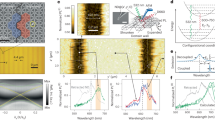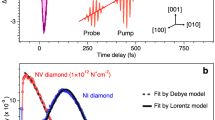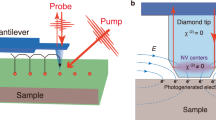Abstract
Optical trapping is a powerful tool to manipulate small particles, from micrometre-size beads in liquid environments1 to single atoms in vacuum2. The trapping mechanism relies on the interaction between a dipole and the electric field of laser light. In atom trapping, the dominant contribution to the associated force typically comes from the allowed optical transition closest to the laser wavelength, whereas for mesoscopic particles it is given by the polarizability of the bulk material. Here, we show that for nanoscale diamond crystals containing a large number of artificial atoms, nitrogen–vacancy colour centres, the contributions from both the nanodiamond and the colour centres to the optical trapping strength can be simultaneously observed in a noisy liquid environment. For wavelengths around the zero-phonon line transition of the colour centres, we observe a 10% increase of overall trapping strength. The magnitude of this effect suggests that due to the large density of centres, cooperative effects between the artificial atoms contribute to the observed modification of the trapping strength. Our approach may enable the study of cooperativity in nanoscale solid-state systems and the use of atomic physics techniques in the field of nano-manipulation.
This is a preview of subscription content, access via your institution
Access options
Subscribe to this journal
Receive 12 print issues and online access
$259.00 per year
only $21.58 per issue
Buy this article
- Purchase on SpringerLink
- Instant access to full article PDF
Prices may be subject to local taxes which are calculated during checkout



Similar content being viewed by others
References
Neuman, K. C. & Block, S. M. Optical trapping. Rev. Sci. Instrum. 75, 2787–2809 (2004).
Grimm, R., Weidemüller, M. & Ovchinnikov, Y. B. Optical dipole traps for neutral atoms. Adv. At. Mol. Opt. Phys. 42, 95–170 (2000).
Vetsch, E. et al. Optical interface created by laser-cooled atoms trapped in the evanescent field surrounding an optical nanofiber. Phys. Rev. Lett. 104, 203603 (2010).
Dienerowitz, M., Mazilu, M. & Dholakia, K. Optical manipulation of nanoparticles: a review. J. Nanophoton. 2, 021875 (2008).
Li, Y. et al. Giant resonant light forces in microspherical photonics. Light Sci. Appl. 2, e64 (2013).
Zambrana-Puyalto, X., Vidal, X. & Molina-Terriza, G. Excitation of single multipolar modes with engineered cylindrically symmetric fields. Opt. Express 20, 24536–24544 (2012).
Chang, D. E. et al. Cavity opto-mechanics using an optically levitated nanosphere. Proc. Natl Acad. Sci. USA 107, 1005–1010 (2010).
Romero-Isart, O., Juan, M. L., Quidant, R. & Cirac, J. I. Towards quantum superposition of living organisms. New J. Phys. 12, 033015 (2010).
Garraway, B. M. The Dicke model in quantum optics: Dicke model revisited. Phil. Trans. R. Soc. A 369, 1137–1155 (2011).
Panat, P. V. & Lawande, S. V. Cooperative effects on optical forces—Dicke’s bullet. Int. J. Mod. Phys. B 16, 3787–3795 (2002).
Bienaimé, T., Bachelard, R., Piovella, N. & Kaiser, R. Cooperativity in light scattering by cold atoms. Fortschr. Phys. 61, 377–392 (2013).
Pellegrino, J. et al. Observation of suppression of light scattering induced by dipole–dipole interactions in a cold-atom ensemble. Phys. Rev. Lett. 113, 133602 (2014).
Black, A. T., Chan, H. W. & Vuletić, V. Observation of collective friction forces due to spatial self-organization of atoms: from Rayleigh to Bragg scattering. Phys. Rev. Lett. 91, 203001 (2003).
Doherty, M. W. et al. The nitrogen-vacancy colour centre in diamond. Phys. Rep. 528, 1–45 (2013).
McGuinness, L. P. et al. Quantum measurement and orientation tracking of fluorescent nanodiamonds inside living cells. Nat. Nanotech. 6, 358–363 (2011).
Horowitz, V. R., Alemán, B. J., Christle, D. J., Cleland, A. N. & Awschalom, D. D. Electron spin resonance of nitrogen-vacancy centers in optically trapped nanodiamonds. Proc. Natl Acad. Sci. USA 109, 13493–13497 (2012).
Geiselmann, M. et al. Three-dimensional optical manipulation of a single electron spin. Nat. Nanotech. 8, 175–179 (2013).
Neukirch, L. P., Gieseler, J., Quidant, R., Novotny, L. & Vamivakas, A. N. Observation of nitrogen vacancy photoluminescence from an optically levitated nanodiamond. Opt. Lett. 38, 2976–2979 (2013).
Zemánek, P., Jonáš, A., Šrámek, L. & Liška, M. Optical trapping of Rayleigh particles using a Gaussian standing wave. Opt. Commun. 151, 273–285 (1998).
Aslam, N., Waldherr, G., Neumann, P., Jelezko, F. & Wrachtrup, J. Photo-induced ionization dynamics of the nitrogen vacancy defect in diamond investigated by single-shot charge state detection. New J. Phys. 15, 013064 (2013).
Gieseler, J., Novotny, L. & Quidant, R. Thermal nonlinearities in a nanomechanical oscillator. Nat. Phys. 9, 806–810 (2013).
Fu, C. C. et al. Characterization and application of single fluorescent nanodiamonds as cellular biomarkers. Proc. Natl Acad. Sci. USA 104, 727–732 (2007).
Fu, K.-M. C. et al. Observation of the dynamic Jahn–Teller effect in the excited states of nitrogen-vacancy centers in diamond. Phys. Rev. Lett. 103, 256404 (2009).
Siyushev, P. et al. Low-temperature optical characterization of a near-infrared single-photon emitter in nanodiamonds. New J. Phys. 11, 113029 (2009).
Dicke, R. Coherence in spontaneous radiation processes. Phys. Rev. 93, 99–110 (1958).
Bradac, C. et al. Observation of room-temperature spontaneous superradiance from single diamond nanocrystals. Preprint at https://arXiv.org/abs/1608.03119(2016).
Gross, M. & Harroche, S. Superradiance: an essay on the theory of collective spontaneous emission. Phys. Rep. 93, 301–396 (1982).
Burnham, K. & Anderson, D. Model Selection and Multimodel Inference a Practical Information-Theoretic Approach (Springer, 2002).
Vlasov, I. I. et al. Molecular-sized fluorescent nanodiamonds. Nat. Nanotech. 9, 54–58 (2014).
Rogers, L. J. et al. Electronic structure of the negatively charged silicon-vacancy center in diamond. Phys. Rev. B 89, 235101 (2014).
Juan, M. L., Molina-Terriza, G., Volz, T. & Romero-Isart, O. Near-field levitated quantum optomechanics with nanodiamonds. Phys. Rev. A 94, 023841 (2016).
Monroe, C., Meekhof, D. M., King, B. E., Itano, W. M. & Wineland, D. J. Demonstration of a fundamental quantum logic gate. Phys. Rev. Lett. 75, 4714–4717 (1995).
Mandel, O. et al. Controlled collisions for multi-particle entanglement of optically trapped atoms. Nature 425, 937–940 (2003).
Bradac, C., Gaebel, T., Naidoo, N., Rabeau, J. R. & Barnard, A. S. Prediction and measurement of the size-dependent stability of fluorescence in diamond over the entire nanoscale. Nano Lett. 9, 3555–3564 (2009).
Breunig, M. M., Kriegel, H.-P., Ng, R. T. & Sander, J. LOF: identifying density-based local outliers. SIGMOD Rec. 29, 93–104 (2000).
Acknowledgements
We thank O. Romero-Isart for useful discussions. This work was funded by the Australian Research Council Centre of Excellence for Engineered Quantum Systems (EQuS) CE 110001013. G.M.-T. acknowledges funding by the Australian Research Council Future Fellowship programme.
Author information
Authors and Affiliations
Contributions
M.L.J. and T.V. conceived the research project following the initial idea by T.V. M.L.J., C.B. and B.B. performed the measurements, and M.L.J., C.B., B.B. and T.V. analysed the data. All authors discussed the data. M.L.J., M.J. and G.B. performed the theoretical calculations presented in the manuscript. M.L.J., C.B., G.M.-T. and T.V. wrote the manuscript, and all authors commented on the manuscript.
Corresponding authors
Ethics declarations
Competing interests
The authors declare no competing financial interests.
Supplementary information
Supplementary information
Supplementary information (PDF 897 kb)
Rights and permissions
About this article
Cite this article
Juan, M., Bradac, C., Besga, B. et al. Cooperatively enhanced dipole forces from artificial atoms in trapped nanodiamonds. Nature Phys 13, 241–245 (2017). https://doi.org/10.1038/nphys3940
Received:
Accepted:
Published:
Issue date:
DOI: https://doi.org/10.1038/nphys3940
This article is cited by
-
Cooperative dynamic polaronic picture of diamond color centers
Nature Communications (2024)
-
Generation of reconfigurable optical traps for microparticles spatial manipulation through dynamic split lens inspired light structures
Scientific Reports (2018)
-
Spin-manipulated nanoscopy for single nitrogen-vacancy center localizations in nanodiamonds
Light: Science & Applications (2017)
-
Room-temperature spontaneous superradiance from single diamond nanocrystals
Nature Communications (2017)
-
Working together
Nature Physics (2017)



